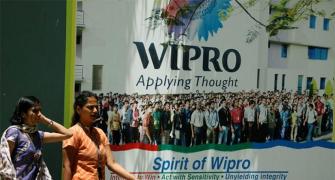'If a regulator anywhere in the world wants to set up a stress test on operational risk, I doubt if they will set up a tougher test than demonetisation.'
'For a country like ours, we need about a dozen banks. Public sector banks will have to consolidate.'
Axis Bank Managing Director & Chief Executive Officer Shikha Sharma spoke to Niraj Bhatt, Hamsini Karthik and Abhijit Lele on the new mechanism for non-performing loans, the bank’s loan portfolio, industry outlook and the bank’s future plans. Excerpts:
 Are there signs of improvement in the asset book?
Are there signs of improvement in the asset book?
We definitely have a greater sense of comfort now. The pockets of stress are well known. For steel, things are improving; it may not have totally turned around, but it’s much better. In power, some things have worked, but I think the Uttar Pradesh elections could be a big game-changer if the government is going to focus on delivering 24x7 power.
However, it does not mean that there would be no haircut. But at least we will have a fairer valuation of those assets. In roads, it’s a question of stuck payments and resolution on arbitration.
Taking lessons from the current asset quality stress on your books, would you be cautious on the infrastructure sector going forward?
Our premise was that the country needed infrastructure and the capital assets to build it, and as bankers, we participated in it. Some things did not pan out as expected. We learn from those lessons.
The good news is that ultimately these assets, which have been built on the ground in a sector like infrastructure, are hard to create and are by and large quality assets. So as and when the economy turns around, some of these assets could turn around. These are not going to be write-off assets.
Can consumer loans be a possible risk like they were after 2008?
We saw a risk on credit cards and small- ticket personal loans in the last cycle. This time, the consumer lending has not been on small-ticket loans, it’s been much broader.
It is home loans, auto loans, personal loans, but more to the salaried segment, and then credit cards and small business loans to productive assets. So while it is still called consumer, it is actually a different form.
Having said that we cannot guarantee that there won’t be an asset quality problem tomorrow. But we have incorporated what we learnt in this cycle.
The two other changes are the presence of robust credit bureaus, which creates some control for the whole system and the regulatory changes on the collection process.
Will the NPA ordinance help in resolving the bad loan problem?
For some of the assets which are productive but getting stuck, we are definitely optimistic on them after the ordinance. The problem is that even when we have a viable asset, if we don’t get the entire consortium of lenders to agree and act, then we delay giving the working capital that is required.
The ordinance, coupled with the Reserve Bank of India (RBI) circular, is creating a forcing mechanism to take decisions.
While I am totally sympathetic to people wanting to have a government cover to be able to take decisions, the fact is that it is very easy not to take decisions. So we need to create an enabling environment and the forcing mechanism to make decisions happen.
That is what the government has tried to take a step at. Again it may not be like a magic wand. The RBI has to set up oversight committees. We need to have enough capacities in those committees for decisions to go through. But at least it is a comprehensively talked through solution.
Won’t the onus of resolution shift to RBI?
That is where some of the news reports surprised me. I would be completely shocked if RBI forces even a single decision. RBI is going to create a framework for the bank consortiums to take a decision.
The RBI is saying that if 60 per cent of the consortium lenders by value and 50 per cent by number agree, then everybody else has to fall in line. If you don’t like the consortium’s decision you can walk out but substitute with another lender. So that’s the forcing mechanism.
Otherwise what happens is that they (dissenting banks) don’t participate and the remaining banks are forced to take the burden of these assets. In a situation where you either fall in line or walk out, you have to find someone else who comes in.
The RBI is saying that once a decision is taken, everybody has to fall in line, because if you chose to participate in that consortium you have to play by the rules. This is totally legitimate.
Do you have any plans of acquisitions?
Our approach to consolidation so far has been that there has to be a strategic fit or where we have had a gap in capabilities, we have acquired, like Enam. We have very few capability gaps now.
Areas of focus and growth would have been microfinance, but we have built a large microfinance portfolio organically. We just have two-three large MFIs and they are at crazy valuations. It doesn’t make sense for us.
What about bank consolidation?
For a country like ours, we need about a dozen banks. Public sector banks will have to consolidate; the government has made it official. If there are going to be five-six public sector banks (PSBs), there will be five-six private banks.
In private banks, there could be consolidation among the smaller ones, but the large ones are comfortable at this time.
Will the deposits collected after demonetisation stay with banks?
We are also watching how consumers are behaving. The savings deposit money was the lazy money kept in cupboards and drawers; it will hang around for some time until an alternative avenue is found.
The current account amount money will start flowing back into businesses. What we are seeing there is that businesses are changing their model from cash to digital. So to that extent some cash should remain in the system.
What were your lessons from demonetisation?
The first one is that if a regulator anywhere in the world wants to set up a stress test on operational risk, I doubt if they will set up a tougher test than demonetisation.
Peak transaction volumes were seven times normal, and there were a lot of changes in rules that happened. It was a high-stress environment from an operational perspective.
We learnt about the gaps where the processes needed strengthening. The second insight came from our employee survey that when people think they are working for a larger cause, which is what bank employees believed they were doing, they don’t mind taking the stress.










